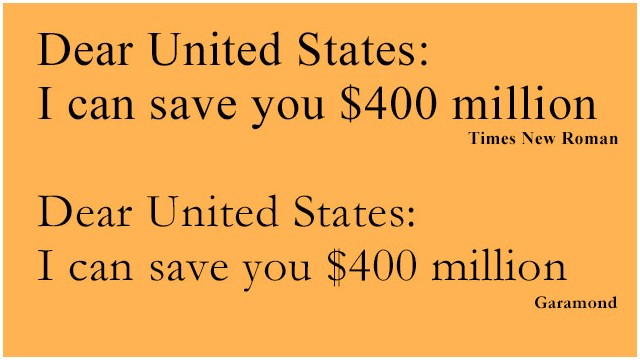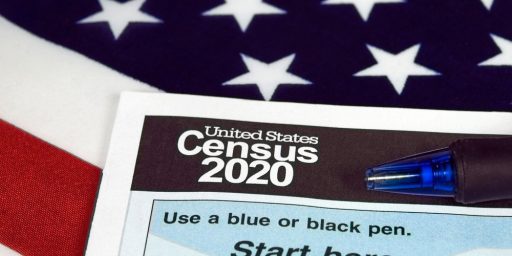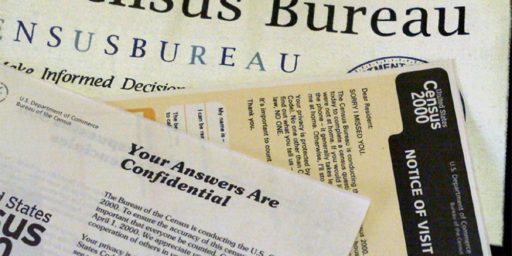Saving Millions By Changing Font
A high school kid has figured out that changing fonts could save the taxpayer millions in printing costs.
A high school kid has figured out that changing fonts could save the taxpayer millions in printing costs.
CNN (“Teen to government: Change your typeface, save millions“):
An e. You can write it with one fluid swoop of a pen or one tap of the keyboard. The most commonly used letter in the English dictionary. Simple, right?
Now imagine it printed out millions of times on thousands of forms and documents. Then think of how much ink would be needed.
OK, so that may have been a first for you, but it came naturally to 14-year-old Suvir Mirchandani when he was trying to think of ways to cut waste and save money at his Pittsburgh-area middle school.
It all started as a science fair project. As a neophyte sixth-grader at Dorseyville Middle School, Suvir noticed he was getting a lot more handouts than he did in elementary school.
Interested in applying computer science to promote environmental sustainability, Suvir decided he was going to figure out if there was a better way to minimize the constant flurry of paper and ink.
Reducing paper use through recycling and dual-sided printing had been talked about before as a way to save money and conserve resources, but there was less attention paid to the ink for which the paper served as a canvas for history and algebra handouts.
“Ink is two times more expensive than French perfume by volume,” Suvir says with a chuckle.
He’s right: Chanel No. 5 perfume costs $38 per ounce, while the equivalent amount of Hewlett-Packard printer ink can cost up to $75.
So Suvir decided to focus his project on finding ways to cut down on the costly liquid.
Collecting random samples of teachers’ handouts, Suvir concentrated on the most commonly used characters (e, t, a, o and r).
First, he charted how often each character was used in four different typefaces: Garamond, Times New Roman, Century Gothic and Comic Sans. Then he measured how much ink was used for each letter, using a commercial tool called APFill® Ink Coverage Software.
Next he enlarged the letters, printed them and cut them out on cardstock paper to weigh them to verify his findings. He did three trials for each letter, graphing the ink usage for each font.
From this analysis, Suvir figured out that by using Garamond with its thinner strokes, his school district could reduce its ink consumption by 24%, and in turn save as much as $21,000 annually.
[…]
With an annual printing expenditure of $1.8 billion, the government was a much more challenging task than his school science project.
Suvir repeated his tests on five sample pages from documents on the Government Printing Office website and got similar results — change the font, save money.
Using the Government Services Administration’s estimated annual cost of ink — $467 million — Suvir concluded that if the federal government used Garamond exclusively it could save nearly 30% — or $136 million per year. An additional $234 million could be saved annually if state governments also jumped on board, he reported.
Gary Somerset, media and public relations manager at the Government Printing Office, describes Suvir’s work as “remarkable.” But he was noncommittal on whether the GPO would introduce changes to typeface, saying the GPO’s efforts to become more environmentally sustainable were focused on shifting content to the Web.
Garamond has been my go-to font for twenty years; goodness knows how much money I’ve saved my employers. But, yes, I save more but operating almost entirely digitally; I just don’t print that much.
Oddly, my first instinct on reading this was to recall Dilbert strip from way back in August of 1996:




![[Update] Analysis of NARA's Letter to Former President Trump](https://otb.cachefly.net/wp-content/uploads/2018/02/top-secret-stamp-magnifying-glass-clearance-large-512x256.jpg)


When I worked for the DIA in the late 60s and early 70s we went from 3rd to 3d, 2nd to 2d to save money.
This post is reason number 276 as to why I love reading this blog. An opportunity for the government to save nearly half a billion dollars without laying off any public sector employees, I hope we run with this. This is something that both democrats and republicans should get behind…a way to throw out the bathwater without throwing out the baby (water = wasted $$$ on printing costs, baby = person who actually still prints out documents, of course).
Also, yet another reminder of how hideously expensive consumables like printer ink are for the average joe (I get it though, unless HP builds a self destruct mechanism into their printers, this really is how they make their money on their printers…which can keep ticking for an insane amount of time).
Now, if we could persuade people to stop using ALL CAPS- especially in font typesets >10pt – we might be getting somewhere. It would both save money and reduce the ‘noise.’
I think we need to investigate why HP charges so f’ing much for ink.
@C. Clavin:
That’s easy. Printers are a loss leader. They make their money on the ink cartridges.
Suggestion: take the boilerplate out entirely and post it on-line instead. Or go electronic. A lot of publicly traded companies are starting to post necessary reports on-line rather than go through the hassle of physically mailing them out to individual stockholders. (Of course, you have to change the regulations and laws so that this is considered an acceptable method of delivery.)
@C. Clavin: I have worked for both HP and Epson. We used to joke that we gave you a free printer when you bought your first ink cartridges. It really was not that much of a joke. The ink is where the money is.
@grumpy realist: I’m old enough to remember when the promise of computers brought with it the promise of a “paperless workplace”. I’m still hoping for it but don’t really expect it in my lifetime.
@Dave Schuler: Tell me about it. I just replaced my printer and almost bought one that cost more to replace the ink cartridges than the printer cost. The salesman clued me in to that fact, thank goodness.
How much would it cost to implement the change across all government organizations? For some reason I feel this number would be comparable to the ink savings (at least for a year).
I remember 25-30 years ago, it was floated around how much companies would save by spelling employee as ’employe’
Has anyone questioned the value of printing anything in the first place? Government is trapped 1,001 different ways in the era of XEROX and movable type.
@grumpy realist:
Actually, we’re mostly there. Most agencies have an “electronic reading room” that contains the most frequently-used and frequently-requested documents, including things that have been the subject of FOIA requests. They save a fortune in photocopying and printing costs that way.
Let’s keep in mind that the bulk of the $1.8B annual printing bill for Uncle Sam is not paying for ink. (Although any excuse to get people to stop using the hideous default Micro$oft fonts is a good excuse. Death to Arial!)
Ink is just one aspect of the cost. Some fonts will use less ink but will stretch the type out and take up more lines with the possibility of using more paper. As an experiment, take a short 4-5 line paragraph and run the different font sizes. The paragraph will range from 3-6 lines depending on the font size. Garamond has the dual advantage of using less ink but also shrinking the paragraph.
There must be some hideous font that’s both illegible and saves more money than Garamond.
I say we all need to learn to read Braille. Think of how much we would save on fonts AND ink!
I wonder how much the retraining and/or changing of templates would cost. It’s possible that it would save money in the long run but they don’t have the funding to do it in the short run.
@rudderpedals: With our luck, it will soon be discovered the most economical font is actually Comic Sans.
@Mikey: you are an evil evil person.
@Ron Beasley: I recall ancient computer generated college class schedules using “R” for Thursday instead of “Th” so it would only be 1 character using less memory.
@James in Silverdale, WA:
Sadly, it’s not just limited to printing. There was an article last week on a government agency whose business processes would have been perfectly at home in the 1960s or even 1950s. I can testify from personal experience that’s not isolated to a single agency.
Shouldn’t we be calculating ink costs using generic ink that costs 1/4 as much as the name-brand kind? That would be easier cost savings than switching fonts which might come with layout and accessibility issues.